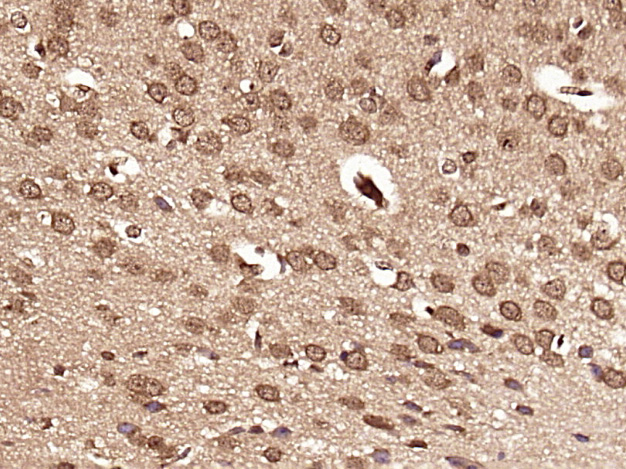
IHC-P analysis of human liver tissue using GTX47496 DHX30 antibody at 1:100. Left to right: DAPI, DHX30, Merge. Low pH, heat-induced antigen retrieval method utilizing Sodium Citrate buffer was performed.
DHX30 antibody, N-term
GTX47496
ApplicationsImmunoHistoChemistry, ImmunoHistoChemistry Paraffin
Product group Antibodies
TargetDHX30
Overview
- SupplierGeneTex
- Product NameDHX30 antibody, N-term
- Delivery Days Customer9
- Application Supplier NoteIHC-P: 2-10 ug/ml. *Optimal dilutions/concentrations should be determined by the researcher.Not tested in other applications.
- ApplicationsImmunoHistoChemistry, ImmunoHistoChemistry Paraffin
- CertificationResearch Use Only
- ClonalityPolyclonal
- Concentration0.5-1 mg/ml
- ConjugateUnconjugated
- Gene ID22907
- Target nameDHX30
- Target descriptionDExH-box helicase 30
- Target synonymsDDX30, NEDMIAL, RETCOR, ATP-dependent RNA helicase DHX30, DEAD/H (Asp-Glu-Ala-Asp/His) box polypeptide 30, DEAH (Asp-Glu-Ala-His) box helicase 30, DEAH (Asp-Glu-Ala-His) box polypeptide 30, DEAH box protein 30, DEAH-box helicase 30, putative ATP-dependent RNA helicase DHX30, retina co-repressor
- HostRabbit
- IsotypeIgG
- Protein IDQ7L2E3
- Protein NameATP-dependent RNA helicase DHX30
- Scientific DescriptionDEAD box proteins, characterized by the conserved motif Asp-Glu-Ala-Asp (DEAD), are putative RNA helicases. They are implicated in a number of cellular processes involving alteration of RNA secondary structure such as translation initiation, nuclear and mitochondrial splicing, and ribosome and spliceosome assembly. Based on their distribution patterns, some members of this DEAD box protein family are believed to be involved in embryogenesis, spermatogenesis, and cellular growth and division. The family member encoded by this gene is a mitochondrial nucleoid protein that associates with mitochondrial DNA. It has also been identified as a component of a transcriptional repressor complex that functions in retinal development, and it is required to optimize the function of the zinc-finger antiviral protein. Alternatively spliced transcript variants have been found for this gene. [provided by RefSeq, Feb 2013]
- Storage Instruction-20°C or -80°C,2°C to 8°C
- UNSPSC12352203








